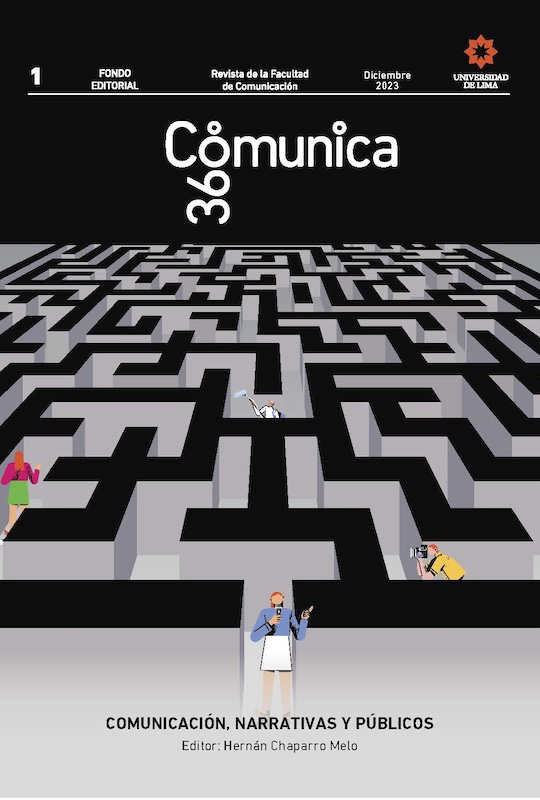Ludonarrativas y narrativa visual para videojuegos: el caso Inka Madness
DOI:
https://doi.org/10.26439/comunica360.2023.n1.6467Palabras clave:
narrativa visual, estructura narrativa, ludonarrativa, gamificación, videojuegosResumen
El presente artículo estudia uno de los elementos fundamentales en el diseño de videojuegos: la estructura narrativa que logra la inmersión del usuario en la construcción del mundo propuesto. Para ello se toma como ejemplo al juego Inka Madness, desarrollado en Perú con temática del Imperio inca para el lanzamiento de Windows Phone. El caso presenta un manejo amplio de las estructuras narrativas con proyección al desarrollo de diversos productos transmedia, como obras de narrativa de ficción, animación o cómics.
Descargas
Referencias
Ayuni, C., León, J., Miranda, M., Norvani, F., & Rojas, A. (2018). Percepción de los estudiantes de los cursos de programación multimedia de la carrera de comunicaciones y signos y símbolos de la carrera de diseño gráfico de la Universidad de Ciencias y Artes de América Latina (UCAL) respecto de la aplicación de una estrategia de enseñanza gamificada destinada al incremento de la motivación y participación en el aula [Tesis de maestría, Universidad Tecnológica del Perú]. https://hdl.handle.net/20.500.12867/1582
Barton, L. (2020, 14 de diciembre). The evolution of video game narratives. Cinemaways. Recuperado el 6 de abril del 2022 de https://cinemaways.com/2020/12/14/the-evolution-of-video-game-narratives/
Cameron, K. (2017). Narrative and gameplay design in the story-driven videogame: A case study on The Last of Us [Tesis de maestría, Auckland University of Technology]. https://openrepository.aut.ac.nz/handle/10292/10955
Chou, Y. K. (2015). Actionable gamification: beyond points, badges and leaderboards. Octalysis Media.
Cohn, N. (2013). Visual narrative structure. Cognitive Science, 37(3), 413-452. https://doi.org/10.1111/cogs.12016
Fabricatore, C. (2007, octubre). Gameplay and game mechanics design: a key to quality in videogames. Conferencia OECD-CERI Expert Meeting on Videogames and Education. https://www.oecd.org/education/ceri/39414829.pdf
Gekker, A. (2010). (Mini) mapping the game-space: A taxonomy of control. En Playful Mapping Collective (Ed.), Playful mapping in the digital age (pp. 134-155). https://networkcultures.org/wp-content/uploads/2016/12/PlayfulMappingInTheDigitalAge.pdf
Goh, R. (2016). Super Mario Bros V1 analysis: Feedback, mastery, burnout and controls. https://www.academia.edu/30307394
González, J., Montero, F., Padilla-Zea, N., & Vela, F. (2009, 24 de agosto). Playability as Extension of Quality in Use in Video Games. Conferencia Interplay between usability evaluation and software development. Proceedings of the second international workshop on the interplay between usability evaluation and software development, Upsala, Suecia. https://www.researchgate.net/publication/221508479
Hocking, C. (2007, 7 de octubre). Ludonarrative dissonance in Bioshock. Click Nothing. Recuperado el 6 de abril del 2022, de https://www.clicknothing.com/click_nothing/2007/10/ludonarrative-d.html
Järvinen, A. (2007, 24-28 de septiembre). Introducing applied ludology: Hands-on methods for game studies. 134-144. En Digra ‘07 - Proceedings of the 2007 Digra International Conference: Situated play (vol. 4, pp. 134-144). The University of Tokyo. http://www.digra.org/wp-content/uploads/digital-library/07313.07490.pdf
Kapp, K. M. (2012). The gamification of learning and instruction. Game-based methods and strategies for training and education. Pfeiffer.
Klevjer, R. (2014). Cut-scenes. En M. Wolf & B. Perron (Eds.), The Routledge companion to video game studies (pp. 301-309). Routledge.
Lévy, P. (2007). Cibercultura. La cultura de la sociedad digital. Anthropos.
Martín-Núñez, M. & Navarro-Remesal, V. (2021). Ludonarrative complexity in video games: A double boomerang. L’Atalante. Revista de Estudios Cinematográficos, (31), 7–32. https://www.revistaatalante.com/index.php/atalante/article/view/902/633
Maté, D. (2016). Interfaces del videojuego: recorrido conceptual y propuesta teórica. Letra. Imagen. Sonido: Ciudad Mediatizada, (15), 89-108. https://dialnet.unirioja.es/descarga/articulo/5837813.pdf
Páez, X. (2013). Narrativa en el videojuego, interfaz y cuerpo [Tesis de maestría, Universidad Andina Simón Bolívar]. http://hdl.handle.net/10644/3850
Pascolati, S. (2017). Illustration in children’s literature. Acta Scientiarum Language and Culture, 39(3), 245-253. https://doi.org/10.4025/actascilangcult.v39i3.35642
Picucci, M. A. (2014). When video games tell stories: A model of video game narrative architectures. Caracteres. Estudios Culturales y Críticos de la Esfera Digital, 3(2), 99-177. https://www.researchgate.net/publication/286392413
Pimenta, S., & Poovaiah, R. (2010). On defining visual narratives. Design Thoughts, (3), 25–46. https://www.idc.iitb.ac.in/resources/dt-aug-2010/On%20Defining%20Visual%20Narratives.pdf
Piñeiro-Otero, T. (2021). Entre la sensación y la contención. La multidimensionalidad de la escucha en inside. L’Atalante. Revista de Estudios Cinematográficos, (31), 103-116. https://revistaatalante.com/index.php/atalante/article/view/878/642
Purnomo, L. A. (2020). Narrative junction: Revisiting branching narrative design approach for role playing video games from the perspectives of cognitive linguistics. En Fantasylicious: Fantasy from the perspectives of literature and linguistics (pp. 76-111). Gerbang Media Aksara. https://www.researchgate.net/publication/339089687
Rimmon-Kenan, S. (2005). Concepts of narrative. COLLeGIUM: Studies across Disciplines in the Humanities and Social Sciences, 1(11), 10-19. https://core.ac.uk/display/14920458?utm_source=pdf&utm_medium=banner&utm_campaign=pdfdecoration-v1
Sánchez, R. (2021). Screenplaying videogames: The adaptation of movie scripts into narrative videogames. creation of video game screenplays [Tesis de bachiller. Universitat Politècnica de Catalunya]. https://doi.org/10.13140/RG.2.2.15570.63685
Schell, J. (2015). The art of game design: A book of lenses. CRC Press.
Scolari, C. (2018). Las leyes de la interfaz. Gedisa.
Seraphine, F. (2014). The intrinsic semiotics of video-games. In search of games’ narrative potential. doi:10.13140/RG.2.2.19968.02560/1
Serrano, P. (2021). Realidad y narrativa. Construcción dramatúrgica de reportajes y documentales y creación de universos de no ficción en la era de lo digital. Fondo Editorial UCAL. https://repositorio.ucal.edu.pe/bitstream/handle/20.500.12637/429/Realidad%20y%20Narrativa%201er%20cap.pdf?sequence=1&isAllowed=y
Young, M. F., Slota, S. T., Travis, R., & Choi, B. (2015). Game narrative, interactive fiction, and storytelling: Creating a “time for telling” in the classroom. En G. P. Green & J. C. Kaufman (Eds.), Video games & creativity, (pp. 199-222). https://doi.org/10.1016/B978-0-12-801462-2.00010-2
Zagal, J., & Mateas, M. (2010). Time in video games: A survey and analysis. Simulation & Gaming, 41(6), 844-868. https://doi.org/10.1177/1046878110375594


